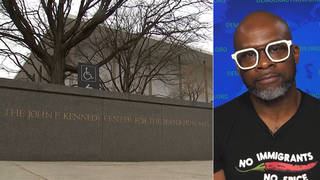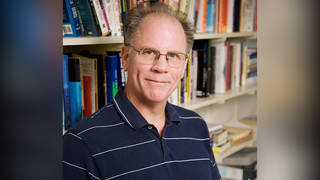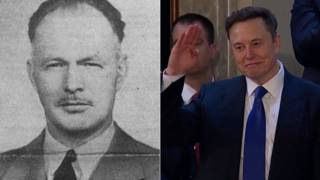
As millions of voters prepare to use electronic voting machines for the first time we take a look at the companies selling these machines and their ties to the Bush administration. We speak with reporter Julie Carr Smyth and author Bev Harris. [Includes transcript]
Click here to read to full transcript By Amy Goodman and the staff of Democracy Now!
September 4, 2003 — As millions of American voters prepare to use electronic voting machines for the first time, questions about who owns and controls these vote-counting machines are rife.
In at least two states, companies with very close ties to the Bush administration are in prime positions to control the voting systems in the 2004 presidential elections.
In Illinois, Populex is the company that is creating the electronic voting system for the state. It was recently revealed that Ronald Reagan’s former Defense Secretary Frank Carlucci now serves on the company’s five-member Advisory Board. Carlucci is also the chairman emeritus of The Carlyle Group, the defense contractor often called the “Ex-President’s Club” because of the high profile partners and advisors on its payroll. These include key players from George W Bush’s inner circle, such as former President Bush and former Secretary of State James Baker III.
Meanwhile in Ohio, Diebold Inc. is one of the companies vying to sell electronic voting machines in that state. Diebold and its CEO have strong Republican ties, specifically to the Bush administration.
A recent article by Julie Carr Smyth in The Cleveland Plain Dealer reported that the head of Diebold is also a top fundraiser for President Bush’s re-election. In a recent fund-raising letter Diebold’s chief executive Walden O’Dell said he is “committed to helping Ohio deliver its electoral votes to the president next year.”
“I think the question that this has raised is, has he crossed the line?,” said The Plain Dealer’s Smyth on Democracy Now! “We hear a lot of comments that a C.E.O. should be allowed to be as politically active as he wants, he’s a businessman, he’s allowed to favor the president. But I think in the business of election systems, the question is, has this crossed the line?”
“Basically what we have is a company that is giving money, hand over fist and helping in campaign strategizing for a particular political party at the same time as making the machines that count the votes,” said Bev Harris, author of Black Box Voting: Ballot-Tampering in the 21st Century.
Harris told Democracy Now!: “We now know that the machines that they’re making that count the votes are not secure from tampering. And add to that, we’ve got a situation where everything inside the machines is secret, we’re not allowed the see how they count the votes. So this is not an acceptable situation.”
Ohio is anticipating spending about $161 million not just on machines but also on the entire implementation of the new system. Diebold is one of ten original companies that came to Ohio to bid for the contract.
In July, O’Dell invited Vice President Dick Cheney to his house for a fundraiser, which poured $500,000 into Cheney’s coffers.
On a trip to Ohio, President Bush visited one of Diebold’s board members–W.R. Timken–who took him on a tour of the company. Timken, like O’Dell, is a “Pioneer”–the name given to wealthy Bush benefactors.
According to Harris, a study of the campaign contributions made by Diebold and its employees revealed an unusual pattern: Hundreds of thousands of dollars were being funneled to a few Republican candidates with very little to any other party.
Harris says that Diebold’s electronic voting machines are wide open to tampering. “There’s actually several different methods that we’ve been looking at. One of the first things you do when you look at any kind of fraud is look what they tell you not to look at,” she said.
Harris managed to obtain the source code that is used in Diebold’s electronic voting system simply by searching the Internet.
Harris told Democracy Now! that she recently uncovered another file on the Diebold site that she says “may very well be the smoking gun that brings this thing down.”
The file, she claims, proves that Diebold has the ability to keep track of election results as they come in. More concerning she says technology exists that would allow Diebold to alter election results.
Diebold has long claimed it does not track votes on Election Day but Harris said this file of election data from San Luis Obispo County, California shows otherwise.
“It is impossible for this file to have existed if there wasn’t some sort of illicit electronic communication going on for remote access,” Harris said.
“It’s against the law to start counting the votes before the polls have closed. But this file is date and time stamped at 3:31 in the afternoon on Election Day, and somehow all 57 precincts managed to call home add them themselves up in the middle of the day. Not only once but three times,” Harris said. “If you have no electronic communications between the polling places and the main office, how does that happen? Because what would you literally have to do is to shut down the polling place in 57 places at once and get in a car and drive this card into the county office. That’s not going to happen.”
Technically, under the Diebold system that means it is possible for someone who has access to the system to monitor the progress of the voting results throughout the day and to potentially manipulate them.
“You see, a modem is always two way,” says Harris. “If you can pull the information in, you can also push it back through the pipeline the other direction. So that means if they can pull the information in, they can also send information back into those machines.”
“We’ve known for some time that this is one of the weakest areas,” Harris said. “If you have remote communication into the system at all, that gives you access without physical access and that’s very dangerous.”
- Julie Carr Smyth, state government reporter for the Cleveland Plain Dealer. She has been reporting on electronic voting machines for the past few months.
- Bev Harris, author of _ Black Box Voting: Ballot-Tampering in the 21st Century_, who uncovered the public internet site where Diebold’s source code was posted.
TRANSCRIPT
AMY GOODMAN: Russian dictator Joseph Stalin once said: “Those who cast the votes decide nothing. Those who count the votes decide everything.”
Well, as millions of American voters prepare to use electronic voting machines for the first time, questions about who owns these vote-counting machines are rife.
One company, Diebold Inc., has been shown to have strong Republican ties, specifically to the Bush administration. Diebold is one of the companies vying to sell electronic voting machines in Ohio.
A recent article by Julie Carr Smyth in The Cleveland Plain Dealer reported that the head of Diebold is also a top fundraiser for President Bush’s re-election. In a recent fund-raising letter Diebold’s chief executive Walden O’Dell said he is “committed to helping Ohio deliver its electoral votes to the president next year.”
In July, O’Dell invited Vice President Dick Cheney to his house for a fundraiser which ended up raising $500,000 for Cheney.
JUAN GONZALEZ: On a trip to Ohio, President Bush visited one of Diebold’s board members–W.R. Timken–who took him on a tour of the company. Timken, is a “Pioneer”–the name given to wealthy Bush benefactors.
And a study of the contributions made to Diebold by its employees revealed an unusual pattern: Hundreds of thousands of dollars were being funneled to a few Republican candidates with very little to any other party.
In Illinois, Populex is the company that is creating the electronic voting system for the state. It was recently revealed that Frank Carlucci of the Carlyle Group fame is now advising Populex. The Carlyle Group is a Defense Contractor often called the “Ex-President’s Club” because of partners and advisors on their payroll, including George Bush Sr.
Here to talk about the political ties to electronic voting machines are Julie Carr Smyth, the State Government reporter for the Cleveland Plain Dealer and Bev Harris, author of Black Box Voting: Ballot-Tampering in the 21st Century, who uncovered the public internet site where Diebold’s source code was posted.
GOODMAN: Julie Carr Smyth can you talk about the letter that you uncovered?
JULIE CARR SMYTH: Yes, Walden O’Dell shortly after he apparently, or I should say I have confirmed, was in Crawford, Texas, at one of Bush’s important strategy meetings came home to Ohio and sent out a letter to his Republican friends inviting them to a fundraiser coming up later this month at his mansion in a Columbus suburb of Upper Arlington.
In the first paragraph was the quote that you mentioned in which he said, he is committed to helping Ohio deliver its electoral votes to Bush. And I think the question that this has raised is, has he crossed the line. We hear a lot of comments on a C.E.O. should be allowed to be as politically active as he wants, he’s a businessman he’s allowed to favor the president. But I think in the business of election systems the question is, has this crossed the line.
GONZALEZ: Could you tell us a little bit about Diebold and its contract, when did it get the contract and how did it receive the contract?
SMYTH: Actually our contract is held up. Ohio is anticipating spending about $161 million not just on machines but on the entire implementation of the new system.
And Diebold is one of ten original companies that came to Ohio to bid for the contract.
As the field has been narrowed by our secretary of state, Ken Blackwell who is also a Republican, Diebold has made every cut. Just yesterday, a judge here said the elimination of one of those firms was unfair and so the entire thing is held up at the moment. But they are in the top three that would divide about $100 million plus in machines around Ohio to replace punch cards. That is where the contract stands right now.
GOODMAN: We’re also joined by Bev Harris, who we’ve had on before, author of “Black Box Voting: Ballot Tampering and the 21st Century” who uncovered the public Internet site where Diebold’s source code was posted. Bev Harris, can you talk further about the connections between the Bush administration and Diebold?
BEV HARRIS: Well, actually Julie Carr Smyth — by the way she is one of the really leading reporters in the country on this matter right now — she has done a marvelous job with that.
Basically what we have is a company that is giving money, hand over fist and helping in campaign strategizing for a particular political party at the same time as making the machines that count the votes. And we now know that the machines that they’re making that count the votes are not secure from tampering. And add to that, we’ve got a situation where everything inside the machines is secret, we’re not allowed the see how they count the votes. So this is not an acceptable situation.
SMYTH: You put all three of those things together and I think it’s really starting to worry people. I mean I’m getting hundreds of Emails and telephone calls of people out there saying, you know, it just doesn’t sound right. And our secretary of state here has said, well as soon as this judge takes the gag off of me I’m going to be able to show exactly how fair and open this process has been. But no one has actually contradicted the fact that Walden O’Dell and others within the field, but certainly he has a C.E.O. is out front being invited to Bush strategy meetings and then coming home and raising money.
Now one of the things that the Ohio Republican party said — it was their fundraiser, that he invited folks to at his home — they have said well, we approached him, he has a very nice house and he holds a lot of civic functions there and that he really shouldn’t be faulted simply because he offered his home.
But O’Dell himself has not really come to the phone on this and I do know that he has also recently been appointed to the Ohio State University board of trustees, by our governor who is also a Republican and is doing a fine job of helping the Republican party here in Ohio.
GONZALEZ: Bev Harris, I’d like to ask you more about — could you summarize how the tampering can occur with Diebold system?
HARRIS: Sure. There’s actually several different methods that we’ve been looking at. One of the things that’s the most concern and what you do when you look at, by the way, any kind of fraud, one of the first things do you is look what they tell you not to look at. Well what Diebold says not to look at always is we don’t have modems, we don’t have remote communications, we only sometimes use modems, well we have a wireless card but we don’t really use it. There’s this massive, 'look over here, don't look over there.’
We’ve known for some time that this is one of the weakest areas because you see if you have remote communication into the system at all, that gives you access without physical access and that’s very dangerous.
Now we just yesterday have uncovered a file — it was on the Diebold site among the 40,000 files and this is an actual election file containing actual votes on election day from San Luis Obispo County, California, and this file may very well be the smoking gun that brings this thing down because it is impossible for this file to have existed if there wasn’t some sort of illicit electronic communication going on for remote access.
What happened specifically is — now it’s against the law to start counting the votes before the polls have closed. But this file is date and time stamped at 3:31 in the afternoon on election day, and somehow all 57 precincts managed to call home add them themselves up in the middle of the day. Not only once but three times. If you have no electronic communications between the polling places and the main office, how does that happen? Because what would you literally have to do is you would have to shut down the polling place in 57 places at once and get in a car and drive this card into the county office. That’s not going to happen.
GONZALEZ: If I can interrupt you, technically that means that it is possible for someone who have access to that to have an idea how the vote is going in an election.
HARRIS: Exactly.
GONZALEZ: Then take — adopt tactics to be able to overcome let’s say a losing situation.
HARRIS: Worse than that. Because, you see, a modem is always two way. If you can pull the information in, you can also push it back through the pipeline the other direction. So that means if they can pull the information in, they can also send information back into those machines.
GOODMAN: Well Bev Harris I want to thank you for being with us, author of “Black Box Voting: Ballot Tampering in the 21st Century and Julie Carr Smyth, State Government reporter for The Cleveland Plain Dealer.You are listening to Democracy Now! back in a minute.











Media Options